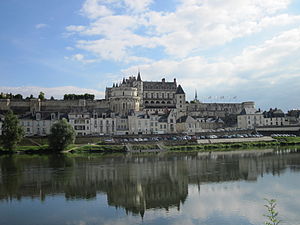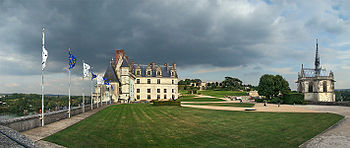- Château d'Amboise
-
The royal Château at Amboise is a château located in Amboise, in the Indre-et-Loire département of the Loire Valley in France.
Contents
History
Origins and royal residence
Built on a promontory overlooking the Loire River to control a strategic ford[1] that was replaced in the Middle Ages by a bridge and the château began its life in the eleventh century, when the notorious Fulk Nerra, Count of Anjou, rebuilt the stronghold in stone.
Expanded and improved over time, on 4 September 1434 it was seized by Charles VII of France, after its owner, Louis d'Amboise, was convicted of plotting against Louis XI and condemned to be executed in 1431. However, the king pardoned him but took his chateau at Amboise (from brochure at Chateau Royale d' Amboise, 2007). Once in royal hands, the château became a favourite of French kings; Charles VIII decided to rebuild it extensively, beginning in 1492 at first in the French late Gothic Flamboyant style and then after 1495 employing two Italian mason-builders, Domenico da Cortona and Fra Giocondo, who provided at Amboise some of the first Renaissance decorative motifs seen in French architecture. The names of three French builders are preserved in the documents: Colin Biart, Guillaume Senault and Louis Armangeart.
Amboise was the site where a garden laid out somewhat in the Italian manner was first seen in France: the site of the origin of the French formal garden. At the time of Charles VIII,[2] an Italian priest, Pasello da Mercogliano, is credited with laying it out. Charles widened the upper terrace, to hold a larger parterre, enclosed with latticework and pavilions; round it Louis XII built a gallery, which can be seen in the 1576 engraving by Jacques Androuet du Cerceau, in Les plus excellens bastimens de France. The parterres have been recreated in the twentieth century as rectangles of lawns set in gravel and a formal bosquet of trees.
King Francis I was raised at Amboise, which belonged to his mother, Louise of Savoy, and during the first few years of his reign the château reached the pinnacle of its glory. As a guest of the King, Leonardo da Vinci came to Château Amboise in December 1515 and lived and worked in the nearby Clos Lucé, connected to the château by an underground passage. Tourists are told that he is buried in the Chapel of Saint-Hubert, adjoining the Château, which had been built in 1491–96.[3]
Henry II and his wife, Catherine de' Medici, raised their children in Château Amboise along with Mary Stuart, the child Queen of Scotland who had been promised in marriage to the future French Francis II.
Amboise conspiracy
In 1560, during the French Wars of Religion, a conspiracy by members of the Huguenot House of Bourbon against the House of Guise that virtually ruled France in the name of the young Francis II was uncovered by the comte de Guise and stifled by a series of hangings, which took a month to carry out. By the time it was finished, 1200 Protestants were gibbetted, strung from the town walls, hung from the iron hooks that held pennants and tapestries on festive occasions and from the very balcony of the Logis du Roy. The Court soon had to leave the town because of the smell of corpses.
The abortive peace of Amboise was signed at Amboise on 12 March 1563, between Louis I de Bourbon, Prince de Condé, who had been implicated in the conspiracy to abduct the king, and Catherine de' Medici. The "edict of pacification", as it was termed, authorised Protestant services only in chapels of seigneurs and justices, with the stipulation that such services be held outside the walls of towns. Neither side was satisfied by this compromise, nor was it widely honored.
Decline
Amboise never returned to royal favour. At the beginning of the 17th century, the huge château was all but abandoned when the property passed into the hands of Gaston d'Orleans, the brother of the Bourbon King Louis XIII. After his death it returned to the Crown and was turned into a prison during the Fronde, and under Louis XIV of France it held disgraced minister Nicolas Fouquet and the duc de Lauzun. Louis XV made a gift of it to his minister the duc de Choiseul. During the French Revolution, the greater part of the château was demolished,[4] a great deal more destruction was done, and an engineering assessment commissioned by Emperor Napoleon Bonaparte in the early 19th century resulted in a great deal of the château having to be demolished.
King Louis-Philippe began restoring it during his reign but with his abdication in 1848, the château was confiscated by the government and became for a while the home in exile to Emir Abd Al-Qadir. In 1873, Louis-Philippe’s heirs were given control of the property and a major effort to repair it was made. However, during the German invasion in 1940 the château was damaged further.
Since 1840, the Château d'Amboise has been listed as a monument historique by the French Ministry of Culture. Today, the present comte de Paris, descendant of Louis-Philippe, repairs and maintains the château through the Fondation Saint-Louis.
Gallery
-
The town of Amboise from the Château.
-
An armoured tank designed by Leonardo da Vinci in the grounds of the Château.
Notes
- ^ The site has been fortified since Gallo-Roman times
- ^ Charles VIII died at Amboise in 1498, having run headlong into the low lintel of a doorway.
- ^ Records show that Leonardo da Vinci was buried in the church of Saint-Florentin, part of the Château Amboise. At the time of Napoleon this church was in such a ruinous state, dilapidated during the French Revolution, that the engineer appointed by Napoleon decided it was not worth preserving; it was demolished and the stonework was used to repair the château. Some sixty years later the site of Saint-Florentin was excavated: a complete skeleton was found with fragments of a stone inscription containing some of the letters of Leonardo's name. It is this collection of bones that is now in the chapel of Saint-Hubert.
- ^ Today's visitor sees about a fifth of what Amboise once was, and can gain an impression of its extent by walking its parapets.
See also
- Gardens of the French Renaissance
- List of castles in France
External links
- Official website
- Ministry of Culture database entry for Château d'Amboise (French)
- Ministry of Culture photos
- Gardenvisit.com: Amboise
- Contemporary Landscape Inquiry Project: Amboise
- "L'histoire du château d'Amboise" (French)
- Château d'Amboise photogallery
Châteaux of the Loire Valley Amboise • Angers • Azay-le-Rideau • Blois • La Bourdaisière • Chambord • Chaumont • Chenonceau • Châteaudun • Cheverny • Langeais • Loches • Menars • Montreuil-Bellay • Montsoreau • Plessis-Bourré • Le Rivau • Saumur • Sully • Talcy • Troussay • Ussé • Valençay • VillandryCategories:- Châteaux of the Loire Valley
- Renaissance architecture in France
- French Renaissance gardens
- Châteaux in France
- Buildings and structures in Indre-et-Loire
- Official historical monuments of France
- 11th-century architecture
- 15th-century architecture
- Landscape design history of France
Wikimedia Foundation. 2010.













